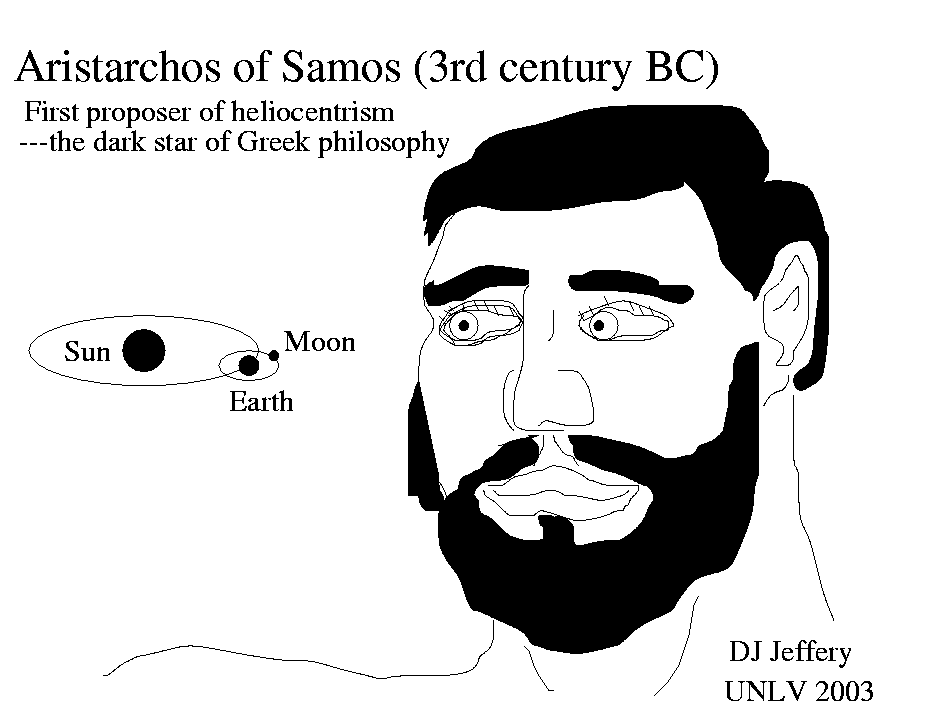
Caption: Aristarchos of Samos (c.310--c.230 BCE), the dark star of ancient Greek astronomy.
Features:
- Not much is known about Aristarchos,
but he is the
first person in recorded history
to propose heliocentrism: i.e., the
heliocentric solar system.
By the way, heliocentrism, of course, implies the daily axial rotation of the Earth---you CANNOT have one without the other in any reasonable theory.
- Pretty much all that is known about
Aristarchos
is detailed in
Wall, B. E. 1975,
"Anatomy of a Precursor: The Historiography of Aristarchos of Samos",
Studies in History and Philosophy of Science 6, 201.
- We only know Aristarchos
proposed heliocentrism
from a few comments in surviving ancient writings.
- The only surviving work attributed to
Aristarchos,
On the Sizes and Distances of the Sun and Moon,
is an important theoretical work on astronomical measurement, but is
based on a
geocentric Solar System.
His methods did NOT work in practice.
His geometry was strong, his instruments were weak.
Ironically,
On the Sizes and Distances of the Sun and Moon,
takes a geocentric perspective.
- The comments on Aristarchos'
heliocentrism
do NOT tell us
Aristarchos' reasons
for proposing heliocentrism---why he
thought heliocentrism was a good
theory.
It's reasonable to guess, these reasons
were at least partly the same reasons that led
Nicolaus Copernicus (1473--1543)
to heliocentrism
(see Copernicus file:
venus_elongation.html)
∼ 18
centuries after
Aristarchos.
Aristarchos
should really have explained his ideas in a book and
made them an unignorable hypothesis.
It might have saved
humankind a lot of time.
- Actually, Aristarchos
may have written a book
on his heliocentric model, but
it has NOT survived if it existed.
The "book" was mentioned by
in a book
attributed to
Archimedes (c.287--c.212 BCE) called
The Sand Reckoner.
But the word "book" may be a mistranslation
from the Greek
word
γραφη
(graphai) which can be
writing as in a book, but can
also just mean drawing
(see Wall, 1975, p. 203).
It may be that a
γραφη
(graphai)
of his heliocentric model
was just shown in person by
Aristarchos to
Archimedes
while the two were hobnobbing
at Mousieon of Alexandria
in Alexandria,
Egypt.
- Despite Aristarchos' priority with
the idea of heliocentrism,
Copernicus is justly credited as the innovator since he presented
a detailed argument that was somewhat convincing and was NOT ignorable.
This is often the way in the history of science.
The giver a convincing proof or argument gets more fame than the speculator---and this seems just. Speculations are many, convincing proofs or arguments take more thought.
- The only other astronomer
to adopt heliocentrism
before Copernicus was
Seleucus of Seleucia (fl. 150 BCE).
Seleucus is said to have
given an argument for heliocentrism---but what that
argument was has NOT survived.
- Aristarchos
and Seleucus
are precursors of a
discovery.
A precursor in history of science jargon is a person who discovers something, but fails to make the world appreciate it's value---a prophet without honor in their time.
- Actually, Aristarchos had his own
partial precursors:
ancient Greek astronomers who thought
the Earth's
motion was possible.
Philolaus (c.470--c.385 BCE) had
moving Earth in his
Philolaic system
(see Ancient Astronomy file:
philolaus_cosmos.html), but
this Solar System model is NEITHER
heliocentric NOR
geocentric and may NEVER
have been considered as realistic
Solar System model.
Hicetas (c.400--c.335 BCE)
and
Heraclides Ponticus (c.390--c.310 BCE) both
suggested
daily rotation
of the Earth
on the Earth's axis
as an explanation of the
diurnal rotation
of the celestial sphere.
There has been a longstanding idea that
Heraclides Ponticus (c.390--c.310 BCE)
also suggested that Mercury
and Venus
orbit the
Sun.
But this is a modern idea now shown NOT to be supported by
ancient texts
(see Wikipedia:
Heraclides Ponticus: Work;
Eastwood 1992).
So Aristarchos remains
the first proposer of
heliocentrism in
recorded history.
Image link: Itself.
Local file: local link: aristarchos.html.
File: Ancient Astronomy file: aristarchos.html.